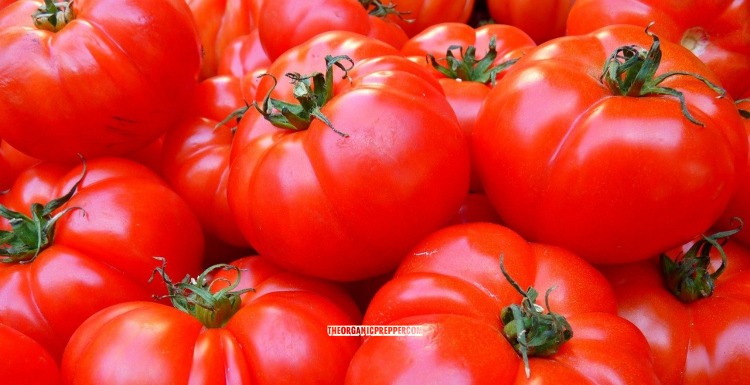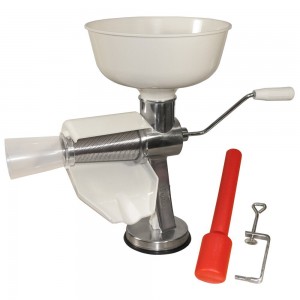If you're new here, you may want to subscribe to my RSS feed. Thanks for visiting!
By Daisy Luther
It’s tomato season, or, as I like to call it, “Make Your Kitchen Look Like a Crime Scene” season!
I’m not gonna lie – there is nothing messier than a bushel of tomatoes getting turned into jars of tomato-ey loveliness. It’s a fair bit of work to process your own tomato products, but the intensely flavored results make it all worthwhile.
From my book, The Prepper’s Canning Guide , here are some of the shortcuts that I have learned to speed along the process of preparing tomatoes for canning.
Using a Food Mill
If you are really into canning, jam making, and processing your own food from start to finish, I recommend getting a food mill. It can save you a LOT of work.
A food mill has a giant funnel at the top where you put your soon to be processed produce. Then, as you push it down and crank it through, it spits the bad stuff out one end and the good stuff out the other end. If you’re using a food mill, you actually don’t even have to peel the tomatoes, because it will spit that out along with the core. The good stuff comes out as a thick puree.
I have this one (it’s less than $50) and have used it for years. In fact, when my friend taught me how to make sauce the very first time I canned, we used a mill like this. If you have children, you can flout the child labor laws and make them crank through your bushels of tomatoes.
The mill will give you a lovely sauce, and you can also get these little gadgets to go with it, and use the mill for making salsa, straining grapes, or removing the seeds from berries. As an added bonus, this kitchen tool is completely low-tech and off-grid.
Peeling Tomatoes
Lots of people already know this little trick, but it bears repeating, especially when you are looking at an entire bushel of those bad boys!
- Begin boiling a pot of water on the stove.
- Also prep a large receiving bowl with very icy ice water.
- Slide tomatoes into a pot of boiling water for 1-2 minutes – you will know they are ready to come out because the skin will start to wrinkle up a little bit. Be careful not to plop them in and get splattered by the boiling water.
- Use a slotted spoon to remove the tomatoes from the boiling water and drop them instantly into the ice bath, where you can leave them for as long as you need to.
- Once the tomato is cool enough to touch, you can easily use your fingers to slide the skin off.
(*FYI Bonus* This process also works like a charm on thin-skinned fruits like peaches, nectarines, and apricots.)
Another method for peeling tomatoes if you have the time is to freeze them whole, then thaw them out. The skin will slide right off, just like it does for the blanching process.
(Hint: Save your core and peels in a bowl – you’ll see why in the directions below.)
Coring the Tomatoes
There’s more than one way to skin a cat – and also, core a tomato!
- You can simply use a paring knife and cut it out.
- You can use your fingertips when pulling the skins off above and pull out the core.
- Use your food mill.
Turning Tomatoes into a Sauce-Like Consistency
Turning your tomatoes into a sauce-like consistency can be done in three different ways.
- You can dump the whole mess of cored and peeled tomatoes into a big stock pot, just as they are, or roughly chopped, and cook them down for many hours.
- You can puree them by batches in a food processor (I use this one) or blender and then cook them down.
- You can put them through the above-mentioned food mill, then into the stock pot, and cook them down.
When cooking the tomatoes down, you want to leave the lid off the pot so the liquid an evaporate.
For me, the choice relies on what I am making. For spaghetti sauces, I prefer the consistency of the tomatoes that come out of the food mill. If I’m making sauces, like ketchup or barbecue sauce, I prefer to use the food processor.
Straining the tomatoes
Last year, inspired by my pectin-free jam method, I decided to try something different with my tomato sauce.
I processed everything as above, but then, instead of cooking it down, I placed colanders in large bowls and pots, and lined them with flour sack towels. Then I poured my processed tomatoes into the colanders and allowed them to drain overnight in the fridge.
This way, instead of letting that tomato broth evaporate into the air, I ended up with two products – a tomato “broth” that I use as a soup base, plus the sauce for whatever product I was making. This also dramatically reduces your cook-down time.
Process tomato broth in your pressure canner for 25 minutes at 7 pounds of pressure, adjusting for altitude. You can process tomato broth along with your marinara in the same batch.
Making use of the skins and cores
Remember all of those tomato skins and cores you tossed into a bowl? You can probably get 2-3 quarts of tomato broth from them.
Put them in a stockpot with a gallon of water. If you want, add in some whole garlic cloves, an onion, and some oregano. Add your bowl of skins and cores, and then simmer it all day long. When you’re done, use a mesh sieve to strain out the chunks, and you’ll be left with a clear, red/gold broth for making soup. This can be canned for future use. I like to pressure can this because I normally add garlic. I use the same specifications as I do with my marinara sauce: Process in your pressure canner for 25 minutes at 7 pounds of pressure, adjusting for altitude. You can process tomato broth along with your marinara in the same batch.
And that’s it!
Consider your tomatoes officially prepped – from this point on you are ready to proceed with your recipe! Do you have any procedures you use when preparing tomatoes for canning?
Here are some recipes for all those tomatoes:
For even more recipes, check out my canning website and my canning cookbook!

















If you dry the tomato peels in a dehydrator or in the oven, you can then make tomato powder in your blender. Add the powder to casseroles, soups, etc.